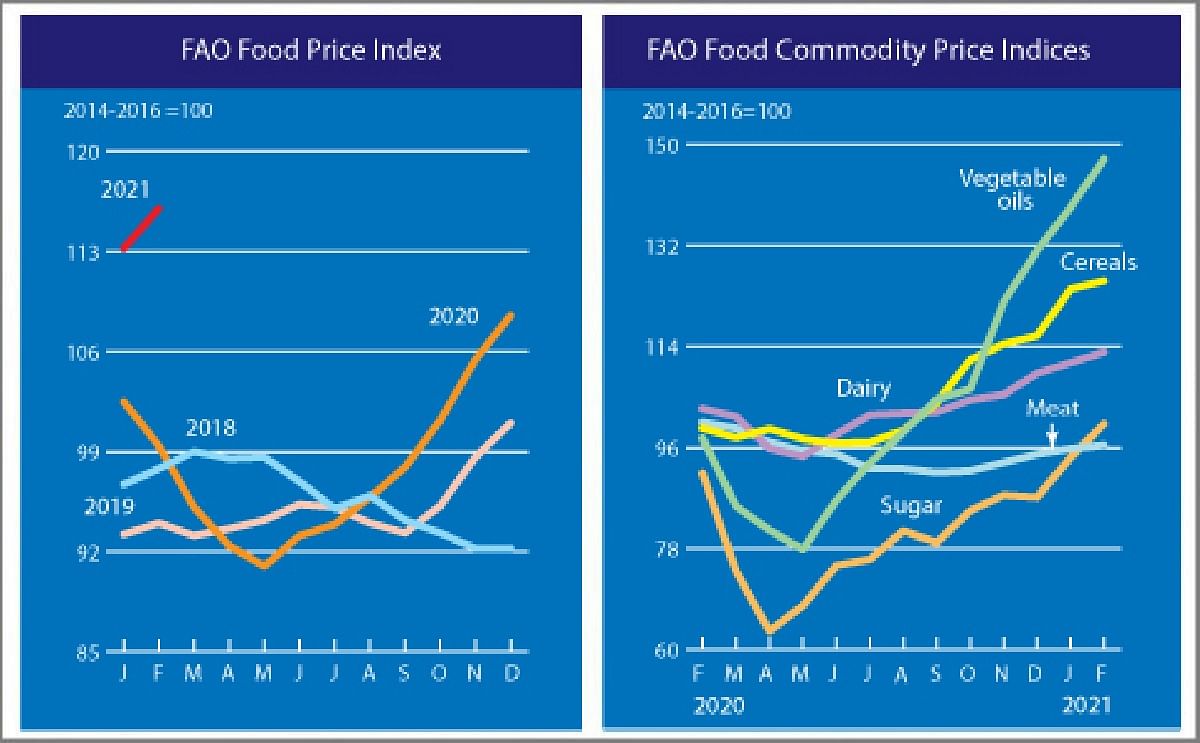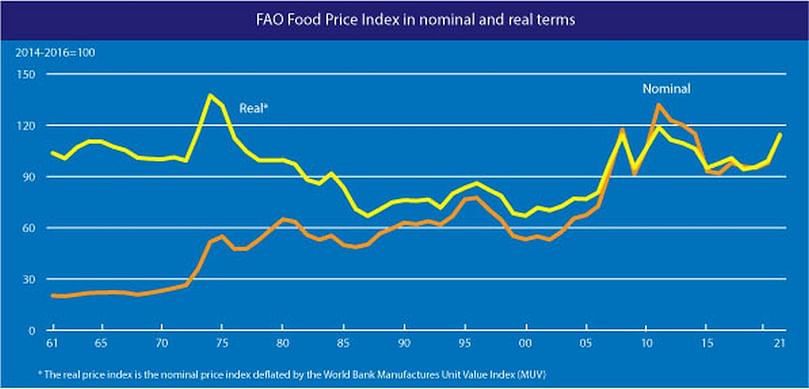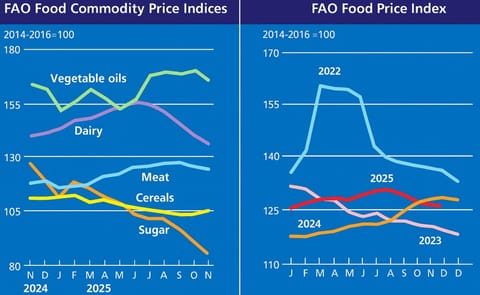FAO Food Price Index rising for nine straight months
FAO Food Price Index rising for nine straight months

The FAO Food Price Index (FFPI) averaged 116.0 points in February 2021, 2.8 points (2.4 percent) higher than in January, marking the ninth month of consecutive rise and reaching its highest level since July 2014.
The February increase was led by strong gains in the sugar and vegetable oils sub-indices, while those of cereals, dairy and meat also rose but by a lesser extent.
The FAO Cereal Price Index averaged 125.7 points in February, up 1.5 points (1.2 percent) from January and 26.3 points (26.5 percent) above its February 2020 level. Among major coarse grains, international sorghum prices increased the most, rising 17.4 percent in February, up 82.1 percent above their values in the corresponding month last year, driven by ongoing strong demand from China.
International maize prices also rose, albeit by only 0.9 percent from the previous month. Maize export prices in February were up 45.5 percent from the previous year, underpinned by continued strong import demand amidst shrinking export supplies. Wheat export prices remained nearly stable in February, but up 19.8 percent from last year's level. International rice prices also edged up some more, driven by demand for lower quality Indica and Japonica rice.
The FAO Vegetable Oil Price Index averaged 147.4 points in February, gaining 8.6 points (or 6.2 percent) from January and marking its highest level since April 2012. The continued strength reflected firmer prices of palm, soy, rape, and sunflower oils.
International palm oil prices rose for a ninth consecutive month in February, fuelled by concerns over low inventory levels in leading exporting countries following below potential outputs. At the same time, soy quotations remained on an upward trajectory, mainly reflecting current global supply tightness prior to the arrival of the new crop in South America.
As for rapeseed and sunflower-seed oils, international prices were underpinned by, respectively, lower than initially expected 2021 production prospects in the European Union and further tightening of export availabilities in the Black Sea region. Noticeably, rising crude oil prices also lent support to vegetable oil values.
The FAO Dairy Price Index averaged 113.0 points in February, up 1.9 points (1.7 percent) from January, rising for the ninth consecutive month and nearing a 40-month high.
In February, international price quotations for butter rose, underpinned by firm imports by China amidst limited export supplies from Western Europe due to a surge in internal demand in view of the upcoming Spring holidays. Quotations for whole milk powder (WMP) increased due to high import purchases and concerns over potentially lower export supplies in New Zealand stemming from dry weather conditions. Skim milk powder prices also increased, reflecting low stocks and tight export availabilities in Europe.
By contrast, reduced demand for spot supplies, coupled with high inventories in the United States of America, weighed on cheese quotations.
The FAO Meat Price Index* averaged 96.4 points in February, up 0.6 points (0.6 percent) from January and marking the fifth consecutive monthly increase, but still 4.1 points (4.0 percent) below its level in the corresponding month last year.
In February, international price quotations for bovine and ovine meats rose mostly on tight supplies in key producing regions, further accentuated by lower processing in Oceania due to the sustained demand for herd rebuilding.
By contrast, pig meat quotations fell, underpinned by reduced purchases from China amidst heavy oversupplies and a rise in unsold pigs in Germany due to the continued ban on exports to Asian markets.
Reduced purchases by China also weighed on global poultry quotations, notwithstanding the winter storm-related supply disruptions in the United States of America.
The FAO Sugar price index averaged 100.2 points in February, up 6 points (6.4 percent) from January, marking the second consecutive monthly increase and registering its highest level since April 2017.
The latest hike in international sugar price quotations was prompted by continued concerns over tighter global supplies in 2020/21, following production declines in key producing countries and strong import demand from Asia.
Logistical constraints hampering shipments from India and the rally in crude oil prices, which may divert more sugarcane crushing to ethanol production in Brazil, the world's largest sugar exporter, contributed to support the higher prices.
Potentially larger monthly price gains were, however, contained by expectations of a production recovery in Thailand and a bumper crop in India in 2021/22.










